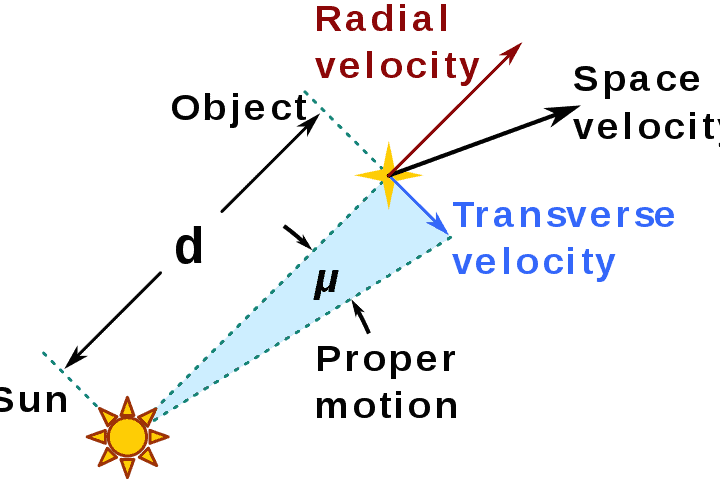
Have you ever wondered why stars appear to move across the sky? Let’s delve into this fascinating phenomenon together.
The apparent movement of stars across the celestial sphere is a result of the Earth’s rotation around its axis. Since our planet rotates from west to east, the objects in space, including stars, appear to move in the same direction.
Interestingly, if you were to observe the sky throughout the night, you would notice a gradual movement of the stars and the entire celestial sphere in space. This rotational movement, relative to the observer’s position, is known as diurnal motion.
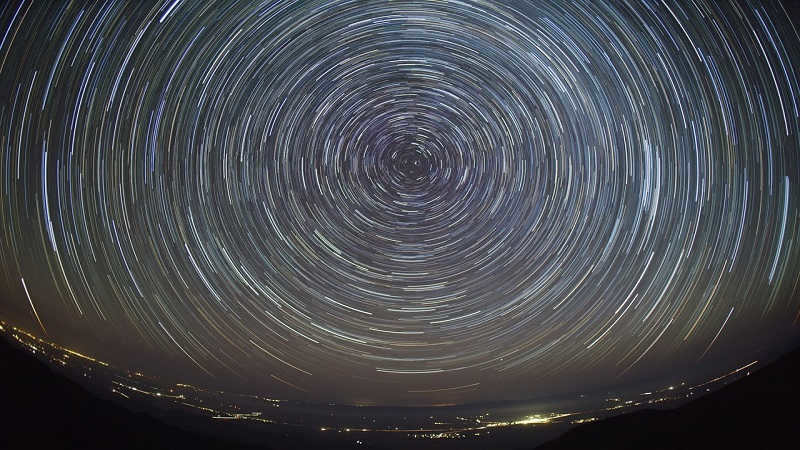
The Impact of Speed on the Motion of Stars in the Sky
Indeed, the motion of stars is barely noticeable due to the vast distance between them and the Earth. However, it is worth noting that the speed of the stars does have an impact on their visible movement. The faster a star moves, the more noticeable its motion across the sky becomes.
What is the star with the fastest self-motion?
When it comes to the star with the highest speed of its own motion, excluding the Sun, Barnard’s star is the one that stands out. Scientists have observed that this star changes its angular coordinates in the sky by 10 seconds per year. This is quite remarkable considering that Barnard’s star is a faint dwarf star located 6 light-years away from our Sun.
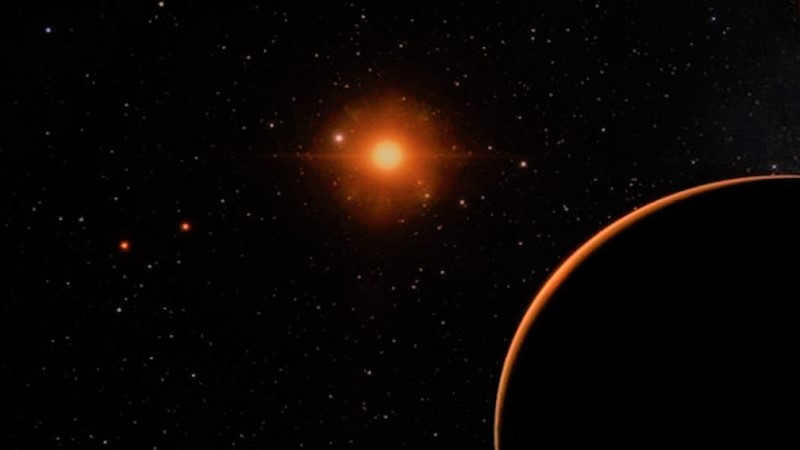
Indeed, other celestial bodies do not possess such a significant proper motion. It is likely that the misleading perception of their immobility is attributed to this.
Movement of stars visibly observed at various latitudes
Above all, it is crucial to comprehend that different vantage points offer distinct perspectives. Naturally, this phenomenon arises from a combination of factors, such as the object’s location and viewing angle, among others.
As it is common knowledge, individuals have acquired the skill of finding their bearings using celestial bodies. One of the straightforward methods for determining the geographical latitude involves measuring the elevation of the North Pole above the horizon. This is because the angular elevation of the North Pole corresponds to the area’s geographical latitude.
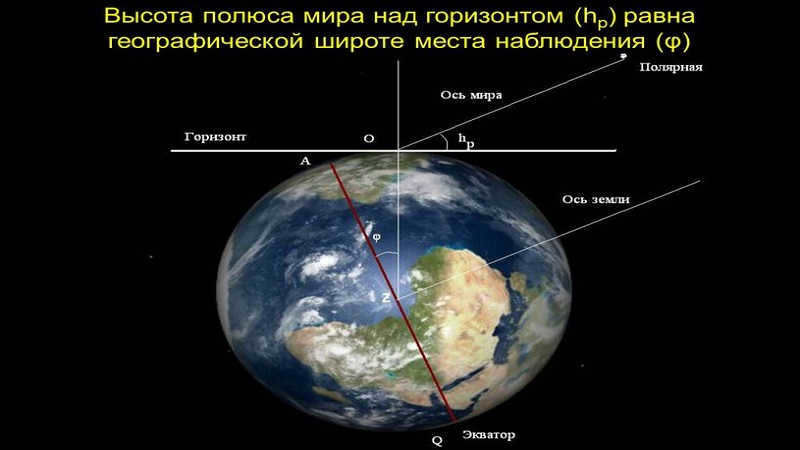
It is important to note that the rotation axis of the celestial sphere in relation to the horizon line changes at different latitudes from which observations are made.
This implies that the apparent motion of stars also varies at different latitudes.
For instance, if observations are conducted at the Earth’s pole, the stars remain fixed in the sky without setting or rising. This is because their circular motion is always parallel to the horizon. In other words, they do not ascend or descend from the boundary between the sky and the Earth’s surface. Thus, their elevation above the Earth remains constant.
However, in the middle latitudes, one can observe the phenomenon of rising, setting, and near-polar stars. When these stars are positioned towards the north pole of the Earth, they emerge above the horizon at a specific time. On the other hand, if these stars are situated towards the south, they will never ascend beyond the horizon line.
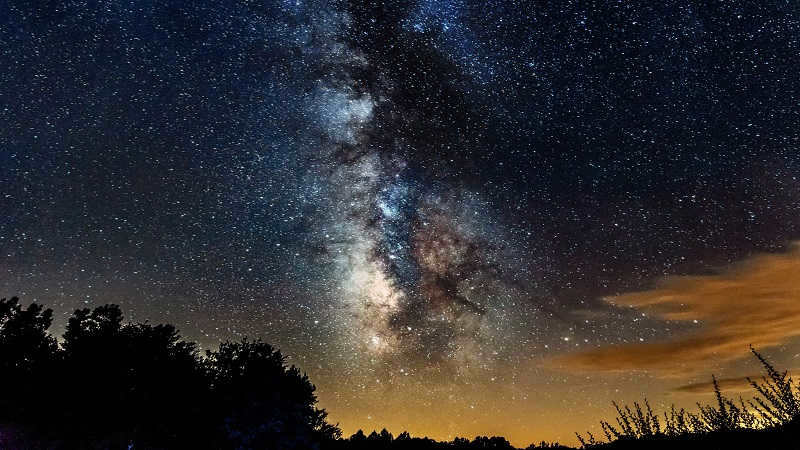
The motion of the stars across the celestial sphere is not easily discernible. When observing the night sky, it appears that stars remain in fixed positions. However, the boundaries of constellations have changed over time. For instance, a thousand years ago, the constellations had different configurations than they do presently.
Due to the unique speeds, trajectories, and varying distances of each celestial body, their apparent movement is relatively inconspicuous to us. It is only over the course of significant periods of time, which can span thousands of years, that any noticeable alterations become apparent to human observers.
Therefore, the motion of the celestial bodies across the sky, as well as the Earth’s rotation on its axis, are responsible for the apparent movement of the stars. It is important to note that our planet also orbits around the Sun, which further affects our view of the stars. Interestingly, the Sun often obstructs our vision, preventing us from seeing many stars.
– I am curious to know the reason behind the luminosity of stars… Perhaps it is so that everyone can eventually rediscover their own guiding light.
Antoine de Saint-Exupery. The Little Prince.

Indeed, neutron stars are celestial objects that represent one of the possible final stages in the evolution of stars. After all, as we are aware, each star follows its own unique life trajectory and ultimately meets its demise.
Neutrons – heavy elementary particles devoid of electric charge. They, together with protons, constitute the primary components of an atomic nucleus.

The Formation Process of a Neutron Star
The emergence of a neutron star is thought to be the consequence of a supernova explosion, representing what remains of the celestial body following the explosion. In simpler terms, it is the ultimate outcome of the eruption or stellar remains.
By the way, if this remains is three times the size of the Sun, its development continues. As a result of the collapse, a black hole emerges.
Scientists state that any member of the main sequence, given that its mass is eight times larger than that of the Sun, has the potential to evolve into a neutron celestial body.
"Project-Technar" is a costless website where one can find or publish technical drawings, term papers, or theses. Find drawings at studiplom.ru
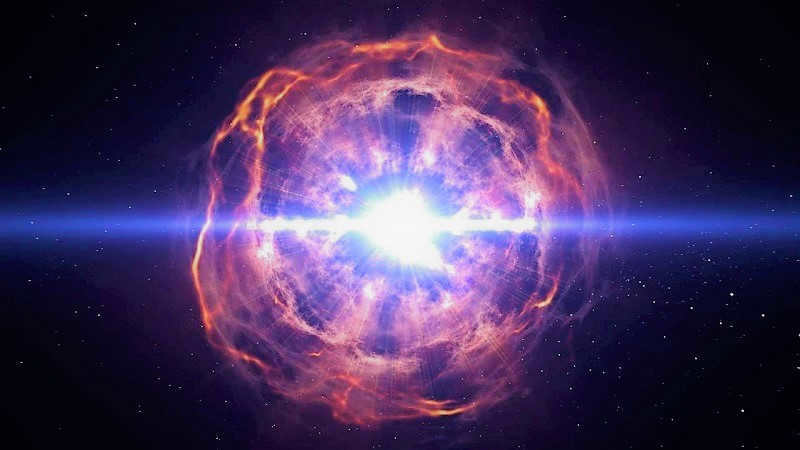
When a neutron star undergoes a detonation, the outer layer swiftly descends onto the core. During this period, a surge in energy occurs, creating a shockwave that propagates through the surrounding matter particles.
In addition, a portion of the material from the imploded layers descends towards the center. As a result, the inner core attains a remarkable density and temperature. Hopefully, it is now comprehensible why a minuscule neutron star possesses immense mass.
It is important to note that the energy of the neutron star post-explosion is not distributed uniformly, but rather in streams. This uneven transfer of energy contributes to its inherent instability. Consequently, the core itself remains intact, although its characteristics such as mass, density, and temperature are altered.
Organization of Neutron Stars
Neutron stars are unique in their composition, consisting primarily of a central core made up of neutrons. This is where they get their name from.
Furthermore, these celestial bodies are encased in a crust composed of dense atomic nuclei, neutrons, and electrons.
Moreover, the structure of these stars can be divided into several distinct parts.
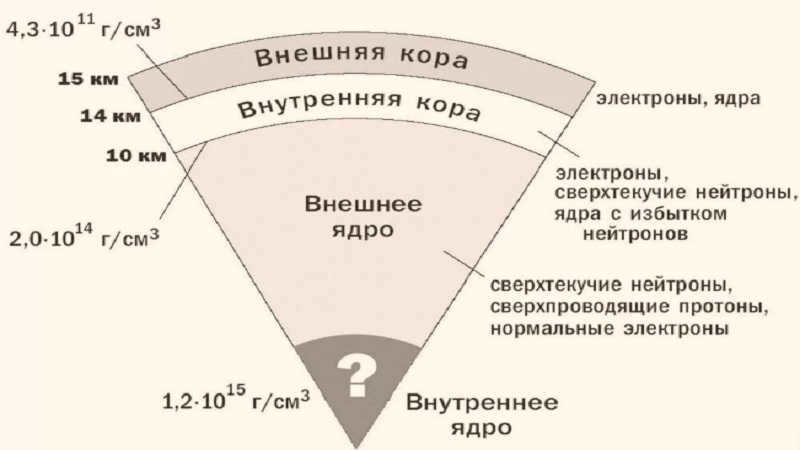
What is the composition of neutron stars?
The atmosphere is a plasma layer that is not more than 100 cm thick. This layer is responsible for the thermal radiation of the neutron star.
The outer crust of the neutron star consists of nuclei and electrons and can have a thickness of several hundred meters. The gas in the outer crust is composed of different elements, with the uppermost layer consisting of ungenerated gas and the middle layer consisting of degenerated gas. As it goes deeper, the gas transitions to a state of relativistic and ultra-relativistic degeneracy.
The interior layer consists of electrons, unbound neutrons, and atomic nuclei with a high number of neutrons. The neutron count increases as you go deeper into this layer, which can extend for several kilometers.
The external nucleus is present in objects with lower mass. It can occupy the entire space up to the core of the star. It primarily consists of neutrons, although there are still some protons and electrons present.
The central nucleus is exclusively found in massive stars and is incredibly dense, with a radius of several kilometers at the very least. The exact composition of the matter in this inner core is currently unknown, but it certainly contains neutrons, baryons, and quarks. Ongoing research and study will eventually uncover all the secrets of neutron stars.
Characteristics of neutron stars
Neutron stars possess unique features that set them apart from other celestial bodies. One notable aspect is their incredibly small size and immense density, surpassing even that of atomic nuclei. However, the gravitational compression does not continue indefinitely due to the pressure exerted by the matter inside the core.
Remarkably, the weight and mass of a neutron star are approximately equal to that of the Sun, yet its radius does not exceed 20 kilometers.
In addition, neutron stars exhibit a distinct rotational motion around their axis, characterized by an exceptionally high speed of several hundred revolutions per second.
Their strong magnetic field is also of great significance, as it heavily influences the other properties and processes that occur within neutron stars.
The gravitational force exerted by stellar bodies is significantly amplified following an outburst, resulting in a tremendous speed of material descent and core compression. This phenomenon is responsible for the suddenness of the ongoing processes.
However, the collision between the outer and inner layers of neutron stars has the potential to break apart atoms within the descending matter, ultimately transforming them into neutrons.
Types of Neutron Stars
Undoubtedly, neutron stars, similar to all other celestial bodies, can be categorized into different types. It has been discovered by scientists that these types can undergo transformations throughout their lifespan.
Primarily, the velocity of their rotation and the intensity of their magnetic field have significant impacts on their evolution. As their rotational speed gradually decreases over time and their magnetic field diminishes, various characteristics and phenomena also undergo alterations.
Neutron stars: classification and instances
Radio pulsars, also known as ejectors, possess rapid rotation rates and powerful magnetic fields. These stars emit charged relativistic particles in the radio frequency range, akin to being ejected. Interestingly, the pioneer among these celestial bodies was the radio pulsar PSR B1919+21.
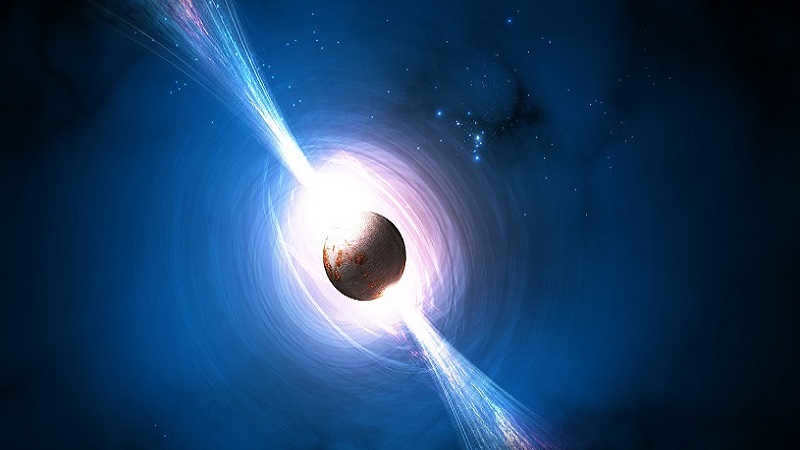
Unlike propellers, pulsars do not emit charged particles. However, their high rotational speed and strong magnetic field keep matter suspended above the surface. Despite being challenging to detect and relatively understudied, this type of luminosity exists.
An X-ray pulsar, also known as an accretor, is distinct because it attracts matter to its surface. Its slower rotation rate allows it to capture plasma, which then heats up due to the magnetic field. As a result, this substance emits bright X-rays.
However, the pulsation occurs due to rotation, during which there is an occurrence of an eclipse of hot material. An instance of this is the initial accretor Centauri X-3. which not only exhibited pulsations in its luminosity, but also continually varied its period.
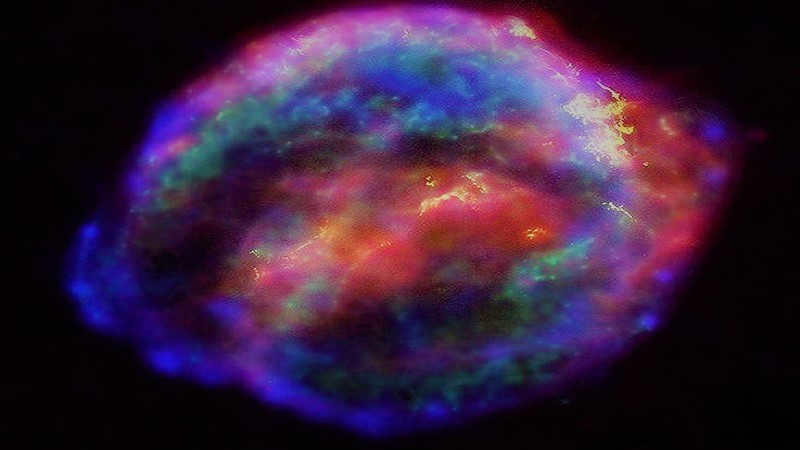
The georotator possesses a relatively low rotational speed, resulting in the accumulation of matter (gas) from the surrounding space through the force of gravity, a phenomenon known as accretion.
Nevertheless, the magnetic field of the georotator confines the plasma within the boundaries of the region, preventing it from reaching the surface.
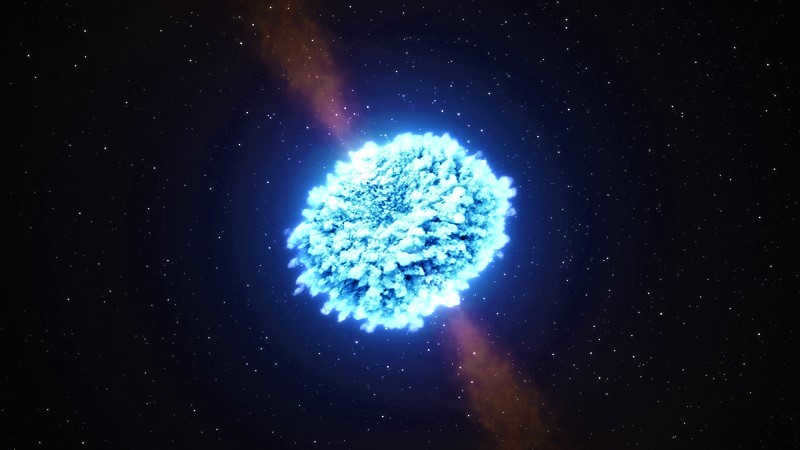
The ergostar is a concept that is theoretically possible. Scientists suggest that this type of object could be formed as a result of the merger or collision of neutron stars.
According to current understanding, an ergostar would have an ergosphere, which is a region of space-time near a black hole. It is believed to exist somewhere between the event horizon and the static limit. In simple terms, the existence of such objects is possible, but not confirmed.
The enigmas of neutron stars
It can be argued that prior to their actual detection, this particular class of stars was first postulated in theory. That is to say, astronomers hypothesized the possibility of the emergence of such celestial entities.
They were only officially identified for the first time in 1967. And it was a radio pulsar B1919+21 from the constellation of Vulpecula.
Currently, the tally of discovered neutron stars stands at over 2500. Surprisingly, only a handful of them reside in binary systems. In fact, the majority of them are solitary stars.
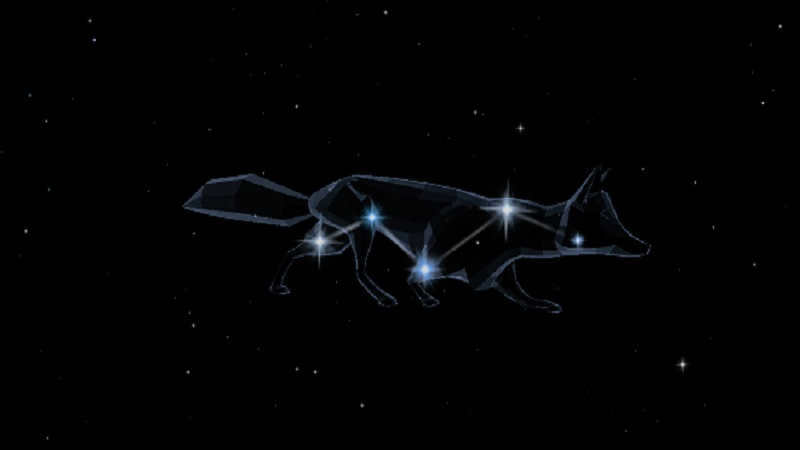
It is astonishing that there are individuals who hold the belief that the solar system is on the verge of being visited by a neutron star, an event that would herald the apocalypse and the ultimate demise of the world as we know it.
There have been reports suggesting the existence of a celestial body with a powerful magnetic field that periodically enters our system. This enigmatic entity is often referred to as the planet Nibiru.
Furthermore, various legends and myths recount instances of this mysterious object having made contact with our planet in the past. Such encounters have always been accompanied by widespread devastation. According to ancient lore, this has occurred on multiple occasions, and if these accounts hold any truth, it would mean that our planet has managed to survive against all odds.
Indeed, astronomers have observed an unidentified celestial body. However, there is no indication of its proximity to Earth or its classification as a neutron star. Occasionally, individuals enjoy embellishing the truth.
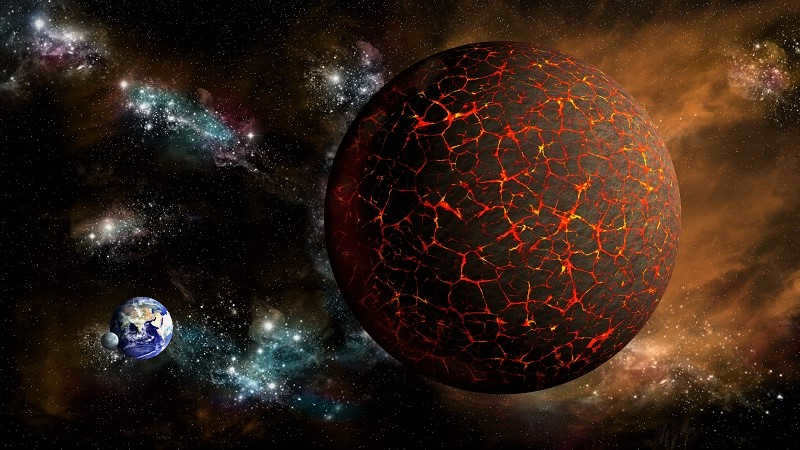
Therefore, we have clarified the definition of a neutron star. I trust you found it intriguing to learn about its formation and the various categories it is classified into.
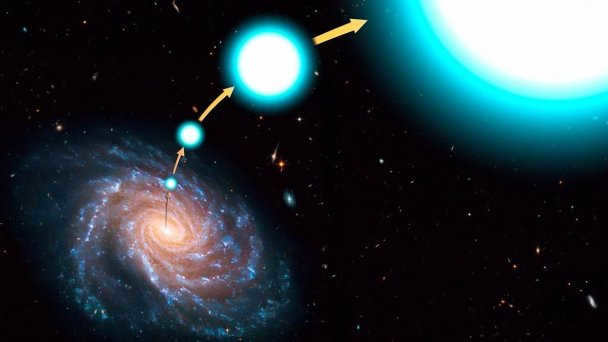
Astronomers have made a groundbreaking discovery, identifying stars that claim to hold the title of the fastest in the entire Milky Way galaxy. One of these stellar objects has been found to exceed speeds of 2300 km/s, while the other reaches an impressive 1700 km/s. To put this into perspective, at such velocities, it would only take a matter of months to traverse the entire solar system. The remarkable journey of these stars will inevitably lead them to depart from the Milky Way and venture into the vast expanse of intergalactic space. Scientists speculate that these celestial bodies embarked on their transgalactic odyssey following the explosive demise of their neighboring stars in supernovae events.
The force of gravity
Within the Galaxy, stars are constantly in motion, orbiting around its center. However, this movement differs greatly from the precise and regular orbits of planets around the Sun. Instead, stars are caught in a turbulent current, swirling around the center of the Milky Way. Each star follows its own unique path and has its own velocity. These individual trajectories are influenced by various factors, such as the star’s birthplace and any encounters it has had with other celestial bodies throughout its history. In the field of astronomy, there exists a specialized area known as space archaeology. The goal of these “archaeologists” is to determine the original positions of stars and reconstruct the shape of the Galaxy as it existed billions of years ago.
Is it possible for a star to depart from the Milky Way? In theory, it is possible, but it would require an immense velocity to overcome the gravitational pull of the galaxy. The necessary speed depends on the distance from the galactic center. The further away a star is from the center, the weaker the gravitational bonds become. The Sun, for example, is located 26,000 light-years away from the center of the Milky Way, which is approximately half the radius of the galaxy. To escape from this distance, a speed of approximately 600 km/s is required. However, the Sun’s speed relative to the center of the galaxy is three times lower, indicating that our star is not going anywhere. This is a typical scenario, as if stars were constantly leaving the galaxy, it would have ceased to exist a long time ago. It takes an extraordinary event for a star to achieve escape velocity.
Getting Away from Home
And these kinds of occurrences actually take place. In 2005, astronomers were completely convinced of this when they discovered a star on the outskirts of the Galaxy, soaring through space at a velocity of 850 km / s.
More specifically, we are referring to the radial velocity. What does that mean? Let’s envision a straight line connecting the star and the viewer’s eye (also known as the line of sight). Let’s designate the direction towards the star as “forward”. The movement of the star in three-dimensional space can be broken down into two components: movement along the line of sight (forward-backward) and movement perpendicular to it (up-down and left-right). The latter can be observed as the star’s displacement across the sky (if its position in the sky is accurately measured, which is a challenging task). Radial velocity represents the speed of movement along the line of sight (forward-backward). This movement cannot be visually perceived: the star does not change its position in the sky, but rather only moves away from or towards the telescope. To an observer, a star appears as a luminous point. Is it possible to determine whether the star is moving away or approaching, especially if it is located tens of thousands of light years away? Even one light-year translates to almost 10 trillion kilometers, so how significant is a few thousand kilometers per second in comparison? Fortunately, the radial velocity can be deduced from the star’s spectrum. In general terms, the light from stars that are farther away from the observer appears redder, while the light from stars that are closer to the observer appears bluer.
If the mysterious star has a radial velocity of 850 km/s, then the overall velocity is even greater: you must also account for the motion “up and down” and “left and right”. This speed is sufficient to escape not only from our region of the Galaxy, but also from the outskirts where the enigmatic luminary was found. The researchers have dubbed this star a hypervelocity (or, alternatively, superfast) star.
Scientists have recently announced an exciting search for runaway stars. So far, in 2021, numerous candidates for hypervelocity stars have already been found (astronomers refer to these as “object candidates” when the data collected has not yet been verified – such as through independent observations on a different telescope). Even though this may seem like a small number, it is important to note that the largest stellar catalog contains over 1.5 billion stars, and the total number in our Galaxy reaches hundreds of billions. Therefore, hypervelocity stars are incredibly rare and fascinating celestial bodies.
When the Galaxy ejects matter
What causes the luminaries to move at incredible speeds? The answer remains unknown. There are multiple potential mechanisms, all of which may be at play. However, most theories are based on a fundamental fact: the majority of stars in the Galaxy exist in pairs that orbit a central point of mass.
The prevailing hypothesis suggests that a supermassive black hole located at the heart of the Milky Way acts as a “gas pedal.” When a pair of stars gets too close to the black hole, one of them gets captured by its gravity and remains in orbit, while the other is flung across the galaxy like a slingshot.
However, there are hypervelocity stars that defy this trend and instead move from the far reaches of the Milky Way towards its center. These stars have never come close to the central black hole and therefore cannot have been influenced by its gravitational pull.
One possibility is that the outskirts of the Milky Way may host their own supermassive black holes. Another potential explanation could be the presence of a smaller black hole, particularly if it is positioned at the heart of a densely populated star cluster. Yet, there is another intriguing scenario that involves supernova explosions.
Separated siblings
The source of stellar energy comes from thermonuclear reactions. However, every star eventually depletes its fuel reserves and transforms into a cooling remnant. Depending on the original star’s mass, it can become a white dwarf, a neutron star, or a black hole. The majority of stars have a mass less than 10 times that of the sun, which means they become white dwarfs – objects with the mass of a star but the size of a planet.
Let’s envision a pair of stars that have both evolved into white dwarfs. These white dwarfs will continue their celestial dance, gradually drawing closer to each other. Eventually, they will become so close that the stronger gravitational pull of the more massive companion will start to strip matter away from its counterpart. As a result, the “cannibal” star may accumulate enough mass to undergo a supernova explosion (specifically, a Type Ia supernova).
Therefore, one of the individuals in the duo is disintegrated into particles. The other is unable to continue revolving around the common center of mass since the duo no longer exists. However, it is also incapable of halting its motion, as motion cannot simply vanish. Visualize a weight being unwound from a rope. What occurs if the rope snaps? The cargo will soar away at the same velocity at which it was spinning. That is precisely what is transpiring with the surviving white dwarf. And given that its orbital speed is approximately one thousand kilometers per second, once it loses its partner, it will transform into a hyper-velocity star.
There are approximately twelve hypervelocity white dwarfs that scientists are aware of, which seem to have endured a similar catastrophic event. This recent research has identified an additional six hypervelocity white dwarfs. Notably, four of the newly discovered white dwarfs have radial velocities exceeding 1000 km/s, with the two fastest reaching speeds of 2300 km/s and 1700 km/s. These velocities surpass those of any other previously known hypervelocity star. It is important to note that the radial velocity is just one component of the overall velocity, meaning the total velocity is likely even greater.
These celestial bodies can be referred to as the swiftest stars in the Milky Way, albeit with certain caveats. Positioned at the very core of our galaxy, the star known as S0-2 revolves around its central black hole. Its velocity during one segment of its orbit reaches a staggering 4000 km/s, yet the gravitational pull of this supermassive devourer prevents the star from escaping. It is conceivable that within the entourage of this behemoth, which possesses a mass equivalent to 4 million suns, there may exist even speedier (as of yet undiscovered) luminaries.
Nevertheless, the pursuit of astronomical knowledge is not akin to a competitive sport, and astronomers are not motivated by breaking any speed records. Rather, hyperfast stars captivate their attention as a relatively unexplored facet of the vast and diverse tapestry of the Milky Way’s existence.

At present, there are extra combined discounts (ranging from 2% to 25%) accessible to 58,741 educational establishments. In order to determine the applicable discount for all staff members of your educational institution, kindly sign in to your personal Infoworks account.


Professional course for retraining
Supporting pedagogical process methodology in the implementation of FSES
You have the opportunity to receive a discount from your educational institution, in addition to the discount already provided by Infowork, based on the number of your colleagues who have completed Infowork courses.
Currently, there are 58,741 eligible educational institutions for additional cumulative discounts ranging from 2% to 25%. To find out the discount applicable to all employees of your educational institution, please log in to your personal Infoworks account.


Enrich your professional skills with our development course
Ensuring legal support for professional activities in the field of education
We offer the opportunity to combine your educational institution’s discount with our current discount (the amount will depend on the number of your colleagues who have already taken Infowork courses).
Currently, 58,741 educational institutions are benefiting from additional discounts ranging from 2% to 25%. To discover the specific discount available to all employees of your institution, simply log in to your personal Infoworks account.




Homeschooling. Tips and tricks for parents
Breakdown of the presentation by individual slides:

2 slide The author has attempted to present the 11th-grade textbook on Astronomy by E.V. Levitan in a more accessible and engaging way for students to grasp the material using the Microsoft Office PowerPoint program with animated features.
This presentation is specifically designed for the topic “Spatial velocities of stars”.
The presentations include entertaining sections and historical content, along with additional tasks for independent study or assessment purposes. To enhance the visualization of the lesson, dynamic models are incorporated in most of the presentations. All illustrations and animations are created by the author. Some of the photos are sourced from the Internet, while others are the author’s own (slides 14-16 in this presentation).
Summary


3. In slide 1, the parallax of Aldebaran is 0.05″. How long does it take for the light from this star to travel from Aldebaran to Earth?
2. The parallax of a star can be determined by the time it takes for its light to reach Earth, which is 20 sv years. Calculate the parallax of this star.
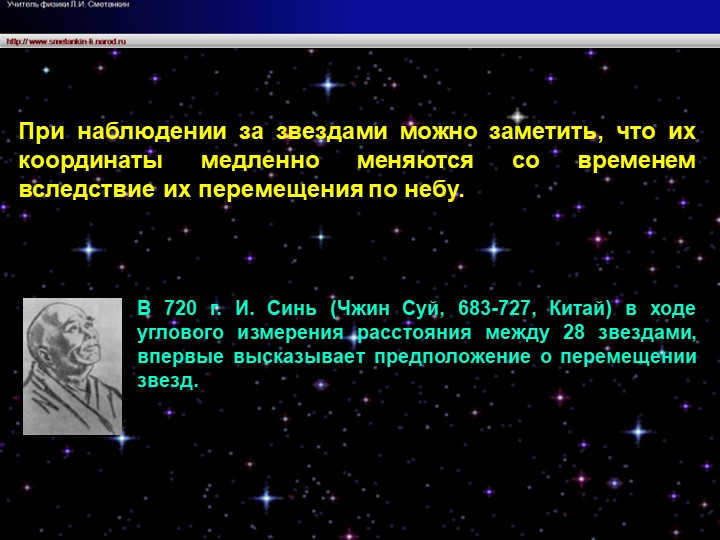
When stars are observed, it becomes evident that their coordinates undergo gradual alterations. This phenomenon can be attributed to the stars’ movement across the sky.
In 720 AD, Xin (Jin Sui, 683-727, China) conducted an angular measurement of the distance between 28 stars and was the first to propose the idea of stars being in motion.
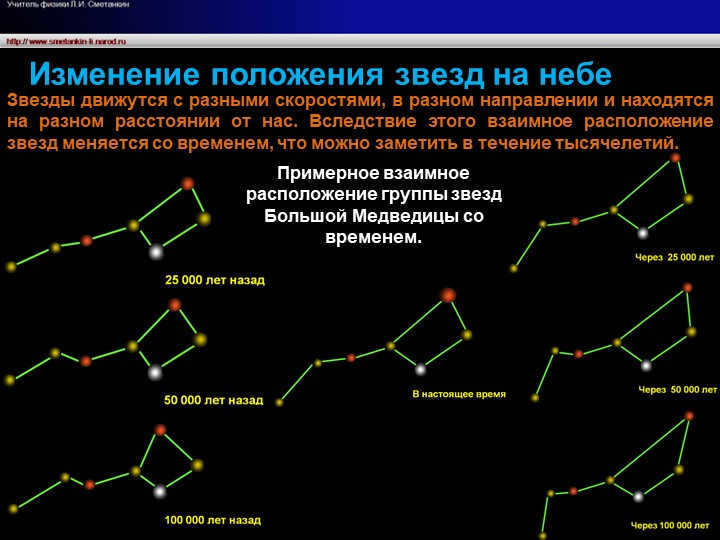
In the fifth slide, we will discuss the phenomenon of stars changing their positions in the sky. Stars have different speeds and move in various directions. Additionally, they are located at varying distances from us. As a result, the relative arrangement of stars evolves over time, which becomes evident over millennia. Let’s take a closer look at the approximate changes in the arrangement of stars in the Big Dipper over time.
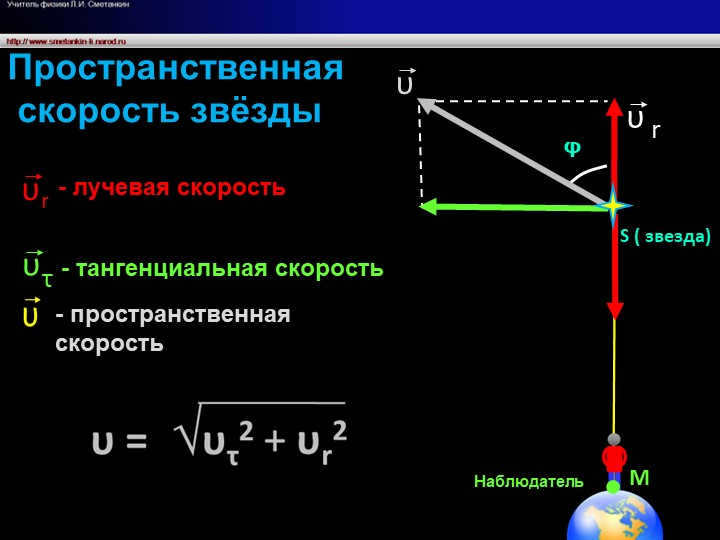
On slide 6, we can see the spatial velocity of a star, denoted as S. The observer, represented by the letter M, measures the tangential velocity (denoted as υrυφυτυr) and the radial velocity. The spatial velocity is a combination of these two velocities and is represented by the symbol ●.

Slide 8
Planet Earth
The celestial sphere
The proper motion of a star, denoted by m, refers to the star’s angular displacement on the celestial sphere within a year.
This proper motion is typically measured in arc seconds per year, represented by the symbol μ (″/year).
By substituting the given numerical data, such as a = 1 astronomical unit (a.u.) = 1.496 – 108 km and t = 1 year = 3.16 – 107 c, we can calculate the tangential velocity in km/s using the formula:
vτ = 4.74μ/π
Additionally, the linear displacement on the celestial sphere, denoted by s, can be calculated using the formula:
s = rμ (where μ is in radians)
Furthermore, we can express μ as:
μ = r/a
(with a = 1 astronomical unit)
Thus, the tangential velocity can also be expressed as:
vτ = rμ/t = aμ/πt
Finally, we can find the value of r by using the formula:
r = a/π
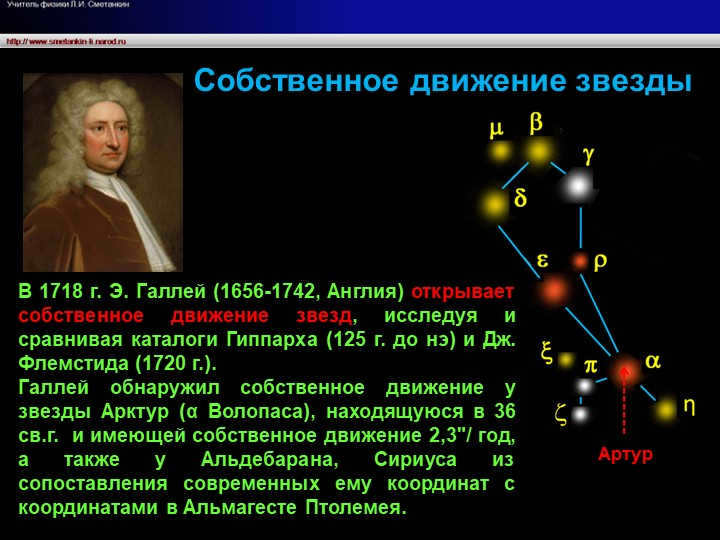
Slide 9: Arthur
In 1718, the English astronomer E. Halley (1656-1742) made an important discovery regarding the motion of stars. He achieved this by carefully examining and comparing the star catalogs created by Hipparchus (125 BC) and J. Flemsteed (1720). Through this comparison, Halley was able to identify the phenomenon known as proper motion in various stars, including Arcturus (α Volopassus), which is located 36 light-years away from Earth and has a proper motion of 2.3 arcseconds per year. He also observed proper motion in stars like Aldebaran and Sirius by comparing their coordinates with those found in Ptolemy’s Almagest. The discovery of proper motion provided astronomers with a deeper understanding of the dynamic nature of stars.


Slide 10 The movements of stars were later investigated by Tobias Mayer (1723 – 1762) and Nicola Lacaille (1713 – 1962).
In 1783, V. Herschel discovered the motion of the Sun in space and accurately determined its direction (apex) to the constellation of Hercules by comparing the known proper motions of 13 stars in the vicinity of the Sun (by the end of the 18th century, the proper motions of 13 stars had been measured).
The motion of a star

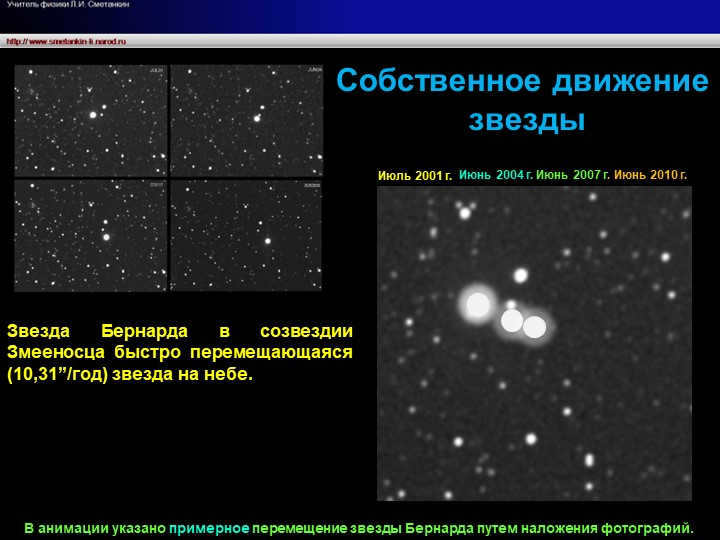
On the 12th of July 2001, Bernard’s Star, located in the constellation of Serpens, was observed to be a rapidly moving star in the sky, with a proper motion of 10.31″ per year.
Over the course of June 2004, June 2007, and June 2010, photos were taken to track the approximate movement of Bernard’s Star. The animation provided showcases this movement.
It is fascinating to witness the proper motion of this star.

Slide 14: Explaining the Doppler Effect
When an ambulance is approaching, an observer hears a sound with a higher frequency. On the other hand, when the ambulance is moving away, the observer hears a sound with a lower frequency.
Interestingly, both observers standing on the sidewalk hear the siren sound of the stationary ambulance at the same frequency.
It’s important to note that if the sound source moves closer to the observer, the pitch of the sound increases compared to when the sound source was at rest. On the other hand, if the sound source moves away from the observer, the pitch of the sound decreases. This fascinating phenomenon is known as the Doppler effect, and it applies to all types of waves.
So, the frequency range can vary from 17 Hz to 20,000 Hz. This means that the observer can perceive sounds within this range, depending on the relative motion between the sound source and the observer.


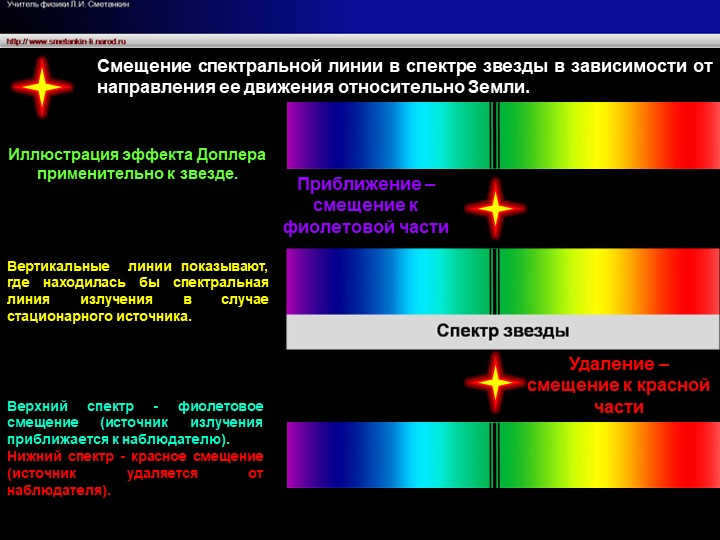
Slide 18
Radial velocity
Radial velocity refers to the change in the position of a star’s spectral line in relation to its motion relative to Earth.
If a star is approaching, its spectral line will shift towards the violet part of the spectrum.
On the other hand, if a star is moving away, the spectral line will shift towards the red part of the spectrum.
This illustration demonstrates the Doppler effect as it applies to a star.
In the upper spectrum, there is a violet shift indicating that the radiation source is approaching the observer.
In the lower spectrum, there is a red shift indicating that the source is moving away from the observer.
The vertical lines represent where the spectral line of radiation would be if the source were stationary.
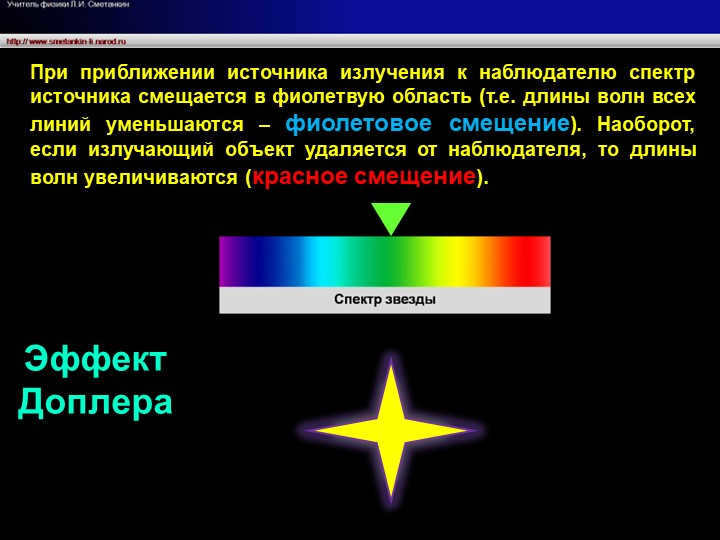
When a radiation source moves closer to an observer, the spectrum of the source shifts towards the violet region, causing a decrease in the wavelengths of all lines (known as a violet shift). Conversely, if the radiating object moves away from the observer, the wavelengths increase, resulting in a red shift. This phenomenon is known as the Doppler effect.


Slide 20: How can you determine if it will rain?
Unbeknownst to you, you are actually measuring the initial velocity of a star, which is the most basic (and practical) characteristic of waves.


In 1868, William Heggins (1824 – 1910, England) became the pioneer in measuring the radial velocities of multiple bright stars.
In 1893, Aristarkh Apollonovich Belopolsky (1854 – 1934) achieved a similar feat in Russia by capturing photographs of stars and conducting precise measurements to determine the radial velocities of 220 bright stars with magnitudes ranging from 2.5 to 4.
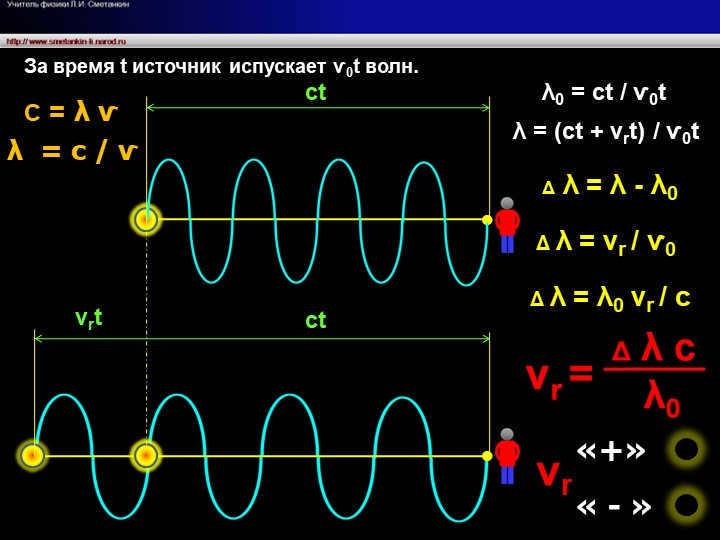
At time t, the source emits v0t waves.
22 slide
●
●
ct
ct
vrt
ѵ
λ0 = ct / v0t
λ = (ct + vrt) / v0t
Δ λ = λ – λ0
Δ λ = vr / v0
λ = c / vv
C = λ v
Δ λ = λ0 vr / c
«+»
« – »
vr
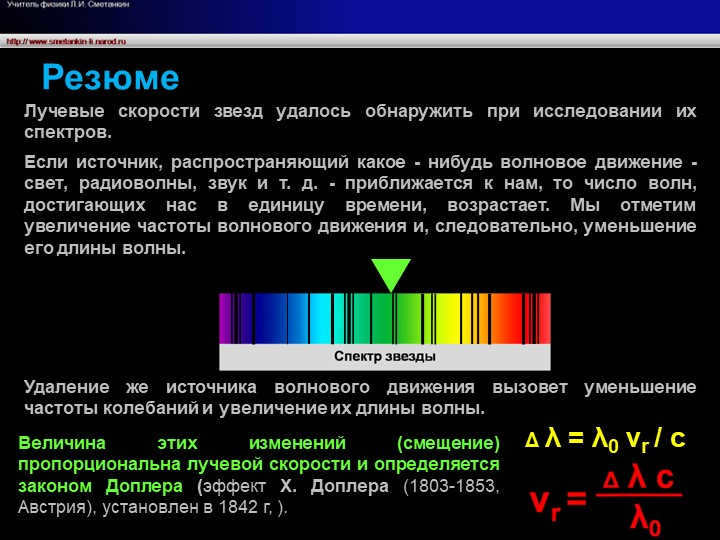
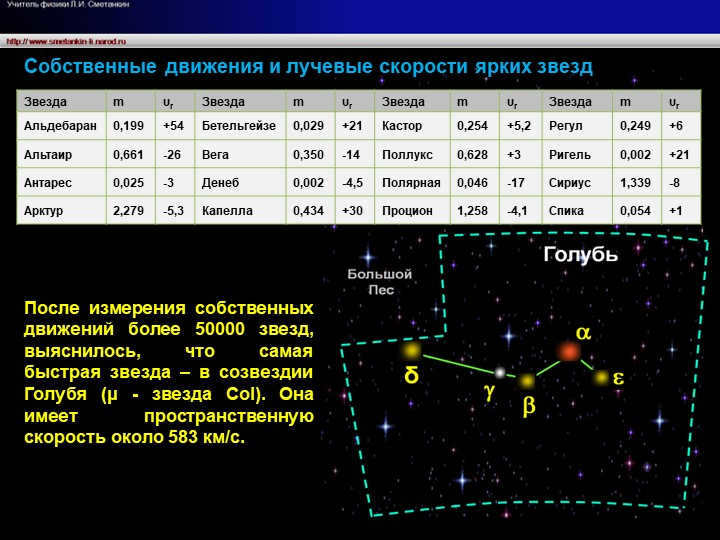
Proper motions and radial velocities of bright stars were measured in a 24-slide presentation. The study included over 50,000 stars and revealed that the constellation Dove is home to the fastest star (μ – Col star) with a spatial velocity of approximately 583 km/s.
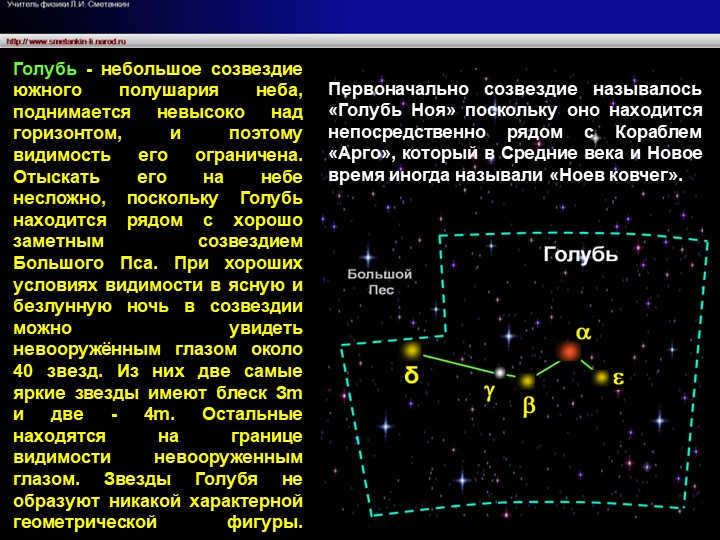

Dove, a small constellation located in the southern hemisphere of the night sky, can be observed low above the horizon. Its visibility is limited due to its low position. The constellation is easily identifiable as it is close to the prominent Big Dog constellation. On a clear and moonless night with good visibility, approximately 40 stars can be seen within the Dove constellation with the naked eye. Among these stars, the two brightest ones have a magnitude of Zm, while two others have a magnitude of 4m. The rest of the stars are at the threshold of naked eye visibility. The stars within the Dove constellation do not form any distinctive geometric pattern.
The constellation was initially known as “Noah’s Dove” due to its close proximity to the Ship Argo, which was occasionally referred to as “Noah’s Ark” during the Middle Ages and Modern era.
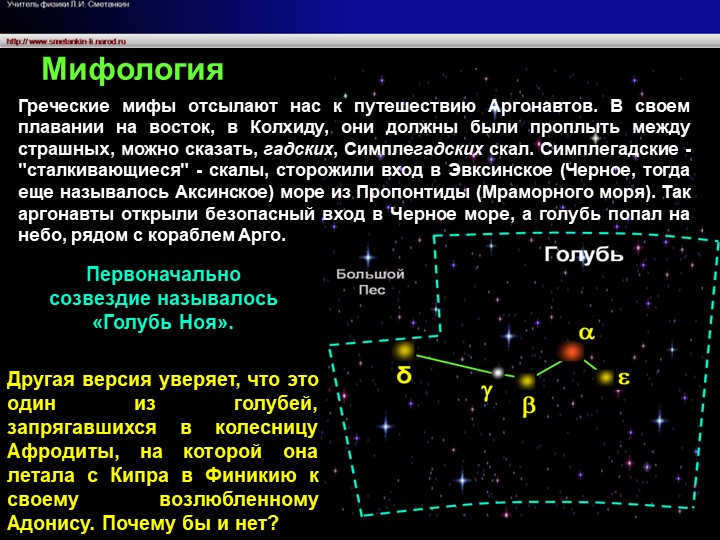

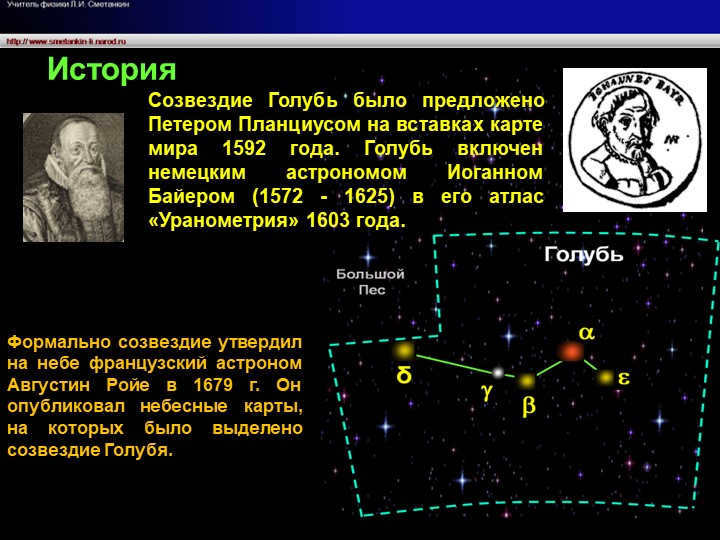
27 slide The constellation of the Dove was officially established in the sky in 1679 by the renowned French astronomer Augustin Royer. Royer’s celestial maps included a prominent depiction of the Dove constellation.
History
The Dove constellation was first proposed by Peter Plancius on the inserts of the 1592 world map. It was later included in the 1603 atlas Uranometria by the German astronomer Johann Bayer (1572 – 1625).
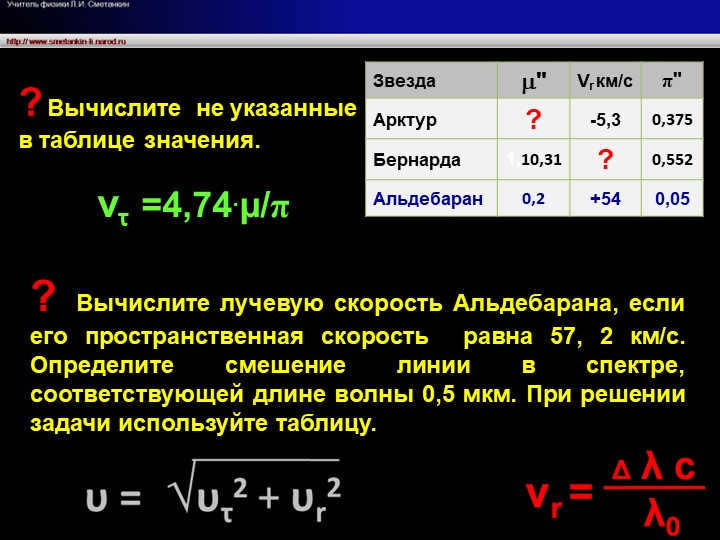

Slide 28: What is the radial velocity of Aldebaran if its spatial velocity is 57.2 km/s? Also, find the line blending in the spectrum corresponding to a wavelength of 0.5 μm. You can use the table to solve this problem. Additionally, calculate the values that are not provided in the table.

Slide number 29 of the D.Z. assignment.
§ 23. Questions – tasks (6).
You have successfully retrieved the presentation and most likely, mentally expressed your gratitude to the author…
Optional task:
Locate an image of Augustin Royer, the French astronomer. Provide a link to the source.
A brief overview of the document:
The teaching of astronomy in the 11th grade provides an excellent opportunity to incorporate modern information and communication (computer) technologies. Information technology can be utilized in various ways during astronomy lessons. Specifically, presentations on astronomy have been developed for each lesson based on the textbook by E. P. Levitan. If you would like access to these presentations, please contact [email protected].
Stars are located millions of times farther away than the Sun, making their horizontal parallaxes significantly smaller. Consequently, measuring such minuscule angles has proven to be an impossible task. In order to determine the distances to stars, astronomers must instead focus on annual parallaxes, which are influenced by the Earth’s movement around the Sun.
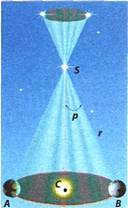
The annual parallax can only be measured for a limited period of time, typically a few months, during which the Earth, along with the telescope, completes its orbit around the Sun and moves through space.
In Copernicus’ era, astronomers attempted to determine the annual parallaxes of stars, as this could serve as undeniable evidence of the Earth’s revolution around the Sun and provide confirmation of the heliocentric model of the universe. However, it was not until 1837 that V. Struve at the Pulkovo Astronomical Observatory in Russia successfully determined the annual parallax of the star Vega in the constellation Lyra. The star Proxima Centauri has the largest parallax among the nearest stars, measuring p = 0.76″, although it is not observable in Europe. Among the bright stars visible in Ukraine, the star Sirius, also known as the Big Dog, has the closest annual parallax at p = 0.376″.
The measurement of the distance to stars is typically expressed in light-years, although the field of astronomy still employs the unit parsec (pc), which is the distance at which the annual parallax p is equal to 1″ (parsec is an abbreviation for parallax-second).
Notable magnitudes of visible stars
The concept of stellar magnitude was initially introduced by the Greek astronomer Hipparchus in the 2nd century BC to quantify the brightness of stars. During that time, astronomers believed that all stars were equidistant from Earth, and their brightness was solely determined by their size. However, we now know that stars within the same constellation can be located at varying distances (Fig. 2.2). Consequently, the apparent stellar magnitude only indicates the amount of energy that our eyes perceive from a star over a specific period of time. Hipparchus classified all visible stars into six distinct classes based on their brightness – known as the six stellar magnitudes. The brightest stars were designated as first magnitude stars, while the dimmer ones were categorized as second magnitude stars. The faintest stars, barely visible in the night sky, were labeled as sixth magnitude stars. In the 19th century, the English astronomer N. Pogson (1829-1891) added an additional criterion to the definition of stellar magnitude: a first magnitude star should be 100 times brighter than a sixth magnitude star.
The amount of light that reaches our eyes from a star is determined by the visible stellar magnitude m. The faintest stars that can still be observed with the naked eye have a stellar magnitude of m = +6 m. Pogson’s formula, also known as Equation (13.4), is used to calculate this magnitude. The brightness E of a star determines the illumination it produces on the Earth’s surface, and it can be measured in lux, a unit of illumination used in physics. According to formula (13.4), if the difference in stellar magnitudes between two luminaries is one, the brightness ratio will be approximately 2.512.
In order to determine the apparent magnitudes of stars in the sky, astronomers have adopted a standard known as the northern polar series. This series consists of 96 stars located around the North Pole. The brightest star in this series, Polaris, has a stellar magnitude of +2 m (Fig. 13.2). Using this standard, stars that can still be seen with the naked eye have a magnitude of +6 m. With the use of binoculars, stars up to +8 m can be observed, while school telescopes can detect stars up to +11 m. With the help of the largest telescopes and modern techniques, faint galaxies with a magnitude of up to +28m can be detected. On the other hand, very bright celestial objects have negative magnitudes. For example, the brightest star in our sky, Sirius, has an apparent magnitude of -1.6 m. The brightest planet, Venus, has a magnitude of -4.5 m, while the Sun has a magnitude of -26.7 m.
Star’s Absolute Magnitudes and Luminosity
Despite being the most brilliant source of light in our sky, the Sun does not necessarily emit more energy than other stars. In the realm of physics, we understand that the luminosity generated by energy sources is contingent upon their proximity. As a result, a small light bulb in your room may appear significantly brighter than a distant spotlight. To quantify the luminosity, or overall radiative power, astronomers introduce the concept of absolute stellar magnitude M. This refers to the stellar magnitude that a star would possess at a standard distance r0=10 pc. Situated roughly at this distance (11 pc, or 36 light-years) from our location is the star Arcturus, which possesses an apparent stellar magnitude nearly equivalent to its absolute magnitude. If the Sun were positioned 10 pc away, it would appear as a relatively faint star with a fifth stellar magnitude. In other words, the absolute stellar magnitude of the Sun is approximately 5 m.
Absolute stellar magnitude M refers to the brightness that a star would have if it were located at a standardized distance of 10 parsecs.
The luminosity of a star is the amount of radiant energy it emits. The unit of luminosity is based on the Sun’s radiation power, which is estimated to be between 4 and 10 26 watts.
The luminosity of a star is a measure of the energy it emits per unit of time, known as its radiative power. In astronomy, the unit of luminosity is based on the Sun’s radiation power, which is estimated to be between 4 and 10 26 watts.
Stars and their Temperature
The temperature of a star can be determined by studying its color, using the laws of blackbody radiation. Measuring the temperature of a star is often done by simply observing its color. However, this method is only reliable for bright stars, as our eyes are not sensitive enough to perceive colors in low light conditions. For faint stars, binoculars or telescopes are used to collect more light, making the stars appear brighter and allowing us to determine their color.
Stars are classified into 7 spectral classes based on their temperature, represented by the letters O, B, A, F, G, K, and M.
The 7 main spectral classes are determined by the colors of stars. Spectral class O includes the hottest blue stars, while spectral class M consists of cold red stars. The Sun, belonging to spectral class G, has a photosphere temperature of +5780 K and a yellow color.
Stars of spectral class O, which are blue in color, have the highest surface temperature and emit more energy in the blue part of the spectrum. Each spectral class is further divided into 10 subclasses, such as AO, A1..A9.
Cosmic bodies with different temperatures have varying radiation intensities. Hot stars emit more energy in the blue part of the spectrum, while cool stars emit more energy in the red part. Planets, on the other hand, predominantly emit energy in the infrared part of the spectrum.
Typically, every star has dark absorption lines in its spectrum, which are created in the rarefied atmosphere of the star and the Earth’s atmosphere, revealing the chemical composition of these atmospheres. It has been discovered that all stars share a nearly identical chemical composition, as the primary chemical elements in the Universe are hydrogen and helium. The main variation between different spectral classes is primarily attributed to the temperature of the stellar photospheres.
Stars’ Radii
The size of stars cannot be determined using the geometric method because stars are located so far away from Earth that, even with powerful telescopes, it was impossible to measure their angular size until recently. As a result, all stars appear as identical, bright points. To calculate the radius of a star, astronomers rely on the Stefan-Boltzmann law.
A star’s radius can be determined by measuring its luminosity and surface temperature.
Surprisingly, there are stars with radii hundreds of times larger than that of the Sun, as well as stars with radii smaller than that of the Earth.
Spectrum-luminosity chart
The Sun is classified as an average star when considering its physical parameters, such as temperature and luminosity. When looking at a large number of different celestial bodies, it is observed that the majority of them fall into the category of having average values for these parameters. For instance, if one were to measure the height and mass of numerous individuals of varying ages, there would be a greater number of people with average values for these measurements. In an effort to determine if there are many stars similar to our Sun in the universe, astronomers devised a diagram known as the spectrum-luminosity diagram or the Hertzsprung-Ressel diagram. This diagram, developed by E. Herzsprung (1873-1967) and G. Ressel (1877-1955), allows for the plotting of a star’s position based on its known temperature and luminosity. The diagram takes the form of a graph, with the x-axis representing the star’s spectral class or temperature, and the y-axis representing its luminosity.
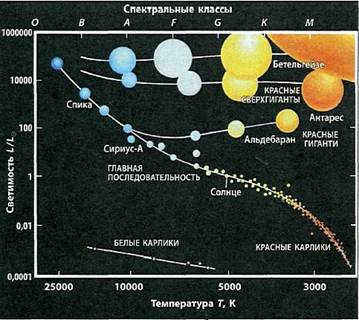
The diagram called Hertzsprung-Ressel is used to show the relationship between the temperature and luminosity of stars. On the x-axis, the temperature of the stars is marked, while on the y-axis, the luminosity is marked. The Sun, for example, has a temperature of 5780 K and a luminosity of 1. In the diagram, the colder stars are positioned on the right side (red), while the hotter stars are on the left side (blue). Stars that emit more energy are located above the Sun, while dwarf stars are below it. The majority of stars, including the Sun, can be found within a narrow band known as the main sequence of stars.
If the Sun is considered to be the central star, then one would expect to see a cluster of points on the diagram representing stars that are similar to the Sun. These stars would be yellow in color and have a similar luminosity. However, astronomers were surprised to find that there were no stars in space that could be considered exact copies of the Sun. Instead, most of the stars on the diagram fall within a narrow band known as the main sequence. The size of main sequence stars varies by a factor of several, and their luminosity is determined by the Stefan-Boltzmann law, which is influenced by their surface temperature. The main sequence band includes stars like the Sun and Sirius. The significant difference in surface temperature among stars of different spectral classes can be explained by their varying masses. Stars with greater mass have greater luminosity. For example, stars in the O and B spectral classes on the main sequence are several times more massive than the Sun, while red dwarfs have a mass tens of times smaller than the Sun.
White dwarfs – these are stars that are hundreds of times smaller in radius than the Sun and have densities millions of times that of water.
Red dwarfs – stars with masses smaller than the Sun but larger than Jupiter. These stars maintain a constant temperature and luminosity for billions of years.
Red giants – stars that have a temperature of 3000-4000 K and a radius tens of times larger than the Sun. Their mass is not significantly greater than that of the Sun. These stars are not in an equilibrium state.
The diagram shows that white dwarfs and red supergiants, despite having similar mass, are separate from the main sequence. Although white dwarfs and red supergiants have approximately the same mass, they differ greatly in size. The mass of white dwarfs of spectral class B is almost the same as the giants of spectral class M. However, their average densities differ significantly. For instance, Betelgeuse, a red giant, has a radius 400 times larger than the Sun, but its mass is nearly the same. As a result, red giants of spectral class M have an average density that is millions of times less than the density of the Earth’s atmosphere. On the other hand, a typical example of a white dwarf is the companion star Sirius.
The primary enigma of the spectrum-luminosity diagram lies in the fact that astronomers have yet to encounter a pair of stars that possess identical physical characteristics – such as mass, temperature, luminosity, and radius. It is probable that stars undergo changes to their physical attributes throughout their evolution, making it highly improbable for us to discover another star in the vast cosmos that originated at the same moment as our Sun, possessing identical initial parameters.
Summary
Stars vary greatly in their physical attributes, including luminosity, temperature, radius, and density. These characteristics are interconnected and can provide insight into a star’s evolutionary path. For example, the Sun is classified as a yellow star and has maintained a stable size for billions of years. In contrast, there are colossal giant stars in the universe that are thousands of times larger than the Sun, as well as diminutive dwarf stars with a radius smaller than Earth’s.
Tests
A. Measured in kilometers.
B. Measured in astronomical units.
C. Measured using parallaxes.
D. Measured in light years.
E. Measured in parsecs.
A. Represents the luminosity of a star.
B. Represents the radius of the star.
C. Represents the brightness of the star.
D. Represents the illumination that the star creates on Earth.
E. Represents the temperature of the star.
A. 1 astronomical unit.
B. 10 astronomical units.
C. 1 solar year.
D. 10 solar years.
E. 1 parsec.
F. 10 parsecs.
A. A star with a surface temperature of +10000 K belongs to the spectral class A.
B. A star with a surface temperature of +10000 K belongs to the spectral class C.
C. A star with a surface temperature of +6000 K belongs to the spectral class C.
D. A star with a surface temperature of +6000 K belongs to the spectral class G.
E. A star with a surface temperature of +3000 K belongs to the spectral class M.
- Which stars have the highest surface temperatures and to which spectral class do they belong?
- What is the distinction between apparent and absolute stellar magnitudes?
- How do astronomers determine the temperature of stars?
- Which color stars have the highest surface temperature? The lowest temperature?
- Do stars exist with a mass lower than Earth’s and a radius smaller than Earth’s?
Key Concepts and Terms:
Absolute stellar magnitude, apparent stellar magnitude, spectrum-luminosity diagram, parsec, north polar series, stellar luminosity, spectral classes.
The birth and life cycle of stars
Astronomers have formulated a theory about the evolution of stars based on the observation of billions of stars of varying ages in space. It can be likened to attempting to comprehend the growth and development of a tree that has been growing for decades within a few hours – one only needs to venture into the forest and study trees of different ages. The universe serves as a cosmic park where stars are born, shine for a period, and eventually perish.
The naked eye can even catch a glimpse of the Orion Nebula, which is located approximately 1000 light-years away.
Observing a star before it becomes visible in the spectrum can be a challenging task. Stars, along with planets, are created from the remnants of old stars exploding, which form rarefied gas and dust clouds. The existence of these gas-dust nebulae, where young worlds are formed, has been discovered by astronomers using advanced telescopes. The constellation Orion and the Pleiades star cluster are two examples of these fascinating “nurseries” where newborn stars are found.
The destiny of a star and the length of its existence rely on the original mass of the star embryo – the protostar. If the mass of the protostar was several times larger than that of the Sun, then it will give rise to hot stars of spectral classes O and B through gravitational contraction. During this contraction, protostars with a mass equal to that of the Sun are heated up to a temperature of 6000 K.
Protostars with a mass that is several times lower than the mass of the Sun can only undergo a transformation into red dwarfs. The minimum mass needed for thermonuclear reactions to occur within a star’s core is approximately 0.08 solar masses. Objects with a lower mass will never develop into stars – instead, they will only emit energy in the infrared portion of the electromagnetic spectrum. Even within our own Solar System, we have observed such celestial bodies – namely the gas giants Jupiter, Saturn, and Neptune. It is possible that in the vast expanse of interstellar space, the number of these cold infrared objects (also known as brown dwarfs) is much greater than that of visible stars.
A star maintaining gravitational equilibrium
Throughout its extensive lifespan, every star possesses the ability to alter its fundamental characteristics such as temperature, luminosity, and radius. Main-sequence stars, however, exist in a perpetual state of gravitational equilibrium, wherein the outer layers are gravitationally compressed towards the core, while the opposing force of heated gases exerts pressure in the opposite direction – away from the core.
A star maintains its parameters in a state of gravitational equilibrium due to the compensation of intense surface radiation with energy sources from its interior, namely thermonuclear reactions. This equilibrium continues until approximately half of the hydrogen in the core is converted into helium, potentially leading to a decrease in the intensity of thermonuclear reactions. The duration of this stationary phase, during which a star’s parameters remain constant for an extended period, is determined by its mass. Calculations indicate that stars like the Sun can maintain equilibrium for at least 10 billion years. In contrast, more massive stars of spectral classes O and B, which experience more intense thermonuclear reactions, shine in equilibrium for approximately 100 million years. The longest-lasting “flickering” occurs in small red dwarfs, whose age can exceed 10 billion years. 11 billion years.
Stars that Change their Brightness
Stars that change their brightness over time are known as variable stars. There are different types of variable stars, including:
- In multiple systems, the brightness of a star can change due to periodic eclipses of objects with different luminosities. An example of such a variable star is Algol, which is a famous double star in the constellation Perseus.
- Another type of variable star is called a physically variable star. The change in brightness in these stars is caused by the decrease in intensity of thermonuclear reactions in the star’s core over time. This leads to a disruption of gravitational equilibrium, resulting in changes in the star’s size and temperature on its surface. On the spectrum-luminosity diagram, these stars do not have a constant position and shift from the main sequence to the right.
The Cepheids are a type of physically variable stars that are particularly noteworthy. They are named after the constellation Cepheus, where the first observed variable star of this type was found. Extensive calculations have revealed that Cepheids undergo changes in their radius, making them akin to peculiar pendulums that oscillate within their own gravitational field. The period of these pulsations is determined by the mass and radius of the star, with Cephea, for example, pulsating with a period of 5.4 days. As time progresses, these pulsations cause the Cepheid to transform into a giant star, potentially shedding its outer layers. Astronomers have mistakenly referred to such objects as planetary nebulae, as it was once believed that they were involved in the formation of new planetary systems. Eventually, the hot core of a planetary nebula contracts and evolves into a white dwarf.
A planetary nebula is created when the balance is disrupted and the star casts off its external layers.
Novae and Supernovae
Stars with a mass several times that of the sun conclude their lives with a magnificent explosion. In 1054, Chinese astronomers witnessed an extraordinarily bright new star that was visible throughout the day for numerous weeks. Chroniclers in Kievan Rus also observed this peculiar star, as it coincided with the year of Yaroslav the Wise’s passing. It was believed that the emergence of this new star foreshadowed a solemn event in the life of Rus, considered to be “God’s sign.” Presently, the Crab Nebula is visible in the location where this enigmatic star once appeared.
The Crab Nebula was formed following the ignition of the Supernova in 1054.
Novae are stars of spectral classes O and B that experience a rapid increase in brightness by hundreds of millions of times within a few days. When a Nova emits an amount of energy almost equal to that of all the stars in the galaxy combined, it is referred to as a Supernova. The Crab Nebula, located in the Taurus constellation, is the remnant of a Supernova that occurred on July 4, 1054, years ago from Earth. The actual outbreak of the Supernova happened approximately 7,500 years ago.
In the last millennium, astronomers witnessed the most recent outbreak of a Supernova on February 24, 1987, in the neighboring galaxy known as the Large Magellanic Cloud. This event involved the explosion of a massive star belonging to the spectral class B, and it outshone all other stars in the galaxy for several weeks.
The Supernova outbreak in the neighboring galaxy, the Large Magellanic Cloud (1987).
A shock wave of neutrino flux that lasted 13 seconds and was thousands of times more powerful than the energy in the optical range was detected approximately 20 hours before the occurrence of the Supernova outburst. This provided astronomers with the first-ever information about a cosmic event that took place nearly 200,000 years ago.
The explosive variable double star known as the new star undergoes a sudden increase in its luminosity by a factor of 100,000 to 10,000,000 (2 to 10^7 times).
A Supernova is a star that experiences a rapid increase in luminosity by billions of times within a few days.
Following a stellar eruption, all the planets encircling it are transformed into a gaseous-dust nebula, paving the way for the potential emergence of a fresh cohort of stars in the times ahead. This signifies the existence of a distinct material cycle within the cosmos: stars – stellar eruption – nebula – and once more, the genesis of youthful stars.
Following a New or Supernova event, a core remains devoid of any energy source. This star gradually contracts in size and continues to emit light solely through gravitational compression, as the star’s potential energy is converted into heat. During this compression, the star’s mass remains constant, leading to an increase in density and the transformation into a white dwarf. If the star’s initial mass was several times greater than that of the Sun, the white dwarf may evolve into a neutron star, with a radius not exceeding a few tens of kilometers and a density reaching the extraordinary value of 1015 g/cm3. The first neutron star was accidentally discovered at Cambridge University in 1967. Astronomers recorded a radio signal with a consistent 1-second period using a small antenna. No visible stars were present in the direction from which the pulses originated, leading astronomers to hypothesize that the radio signal may have originated from an extraterrestrial civilization. Subsequent observations revealed that these periodic signals were emanating from hundreds of other invisible sources, which became known as pulsars. One such pulsar was even detected at the center of the renowned Crab Nebula.
Pulsars and neutron stars: a unique connection
Recent advancements in theoretical calculations have revealed that pulsars and neutron stars are essentially the same celestial objects. The phenomenon can be explained by the principle of conservation of momentum, which is also observed in the sport of figure skating. Skaters utilize this principle to initiate rapid rotation around a central axis. Initially, they extend their arms to the sides and gradually bring them closer to their torso, causing a significant increase in angular velocity. Similarly, when the radius of a star decreases, its angular velocity experiences a similar surge. As an example, consider the Sun, which currently completes one revolution around its axis every 28 days. If the Sun’s radius were to decrease to a mere 10 km, its revolution period would be reduced to just 1 second.
During gravitational compression, the star experiences an increase in its magnetic field strength. As a result, radiation is emitted through the magnetic poles in the form of unique “searchlights” that create a large cone shape in space. It is estimated that there could be millions of neutron stars in our galaxy, but only a few hundred have been identified as pulsars. This is because the majority of these “spotlights” are not directed towards Earth.
A pulsar refers to a celestial object that emits electromagnetic waves in a pulsating manner, following a specific period.
Dark holes
Dark holes are created in the final phase of the life cycle of stars with masses exceeding 3. The peculiar name is derived from the fact that these entities are meant to be imperceptible, as they emit no light beyond their boundaries. Moreover, they possess the ability to attract all matter from the surrounding space.
If a spacecraft approaches the event horizon of a dark hole, it will be unable to escape its gravitational force, as the escape velocity at its surface equals the speed of light, which is 300,000 km/s.
The dark hole prevents elementary particles and electromagnetic waves from exiting its gravitational field.
The Sun’s Evolution
Theoretical calculations suggest that stars like the Sun will never undergo gravitational collapse to become black holes due to their insufficient mass. This means that the Sun can continue to shine as long as it remains in a state of gravitational equilibrium. However, determining the exact age of the Sun is challenging. While we can estimate the age of the Earth to be approximately 4.5 billion years using the decay of heavy chemical elements, the Sun may have formed before the planets.
The solar system originated around 5 billion years ago from a massive cloud of gas and dust.
If stars and planets continue to form at the same rate, the Sun has the potential to illuminate the universe for an additional 5 billion years. Once all the hydrogen in the Sun’s core has been converted to helium, the equilibrium within its interior will be disrupted, possibly resulting in the Sun transforming into a variable pulsating star known as a Cepheid. As a consequence of this instability, the Sun’s radius will begin to expand and the temperature of its photosphere will decrease to 4000 K, causing the Sun to evolve into a red giant. In the Earth’s sky, we will witness the presence of a massive red sphere, with an angular diameter that is ten times larger than the current Sun and measures 5 °. However, the blue sky on Earth will not disappear entirely, as the luminosity of the future Sun will increase tenfold and the surface temperature of our planet will exceed 1000 K. This extreme heat will cause the oceans to evaporate, transforming the Earth into a scorching desert similar to present-day Venus. Within the solar system, temperatures comparable to those experienced on Earth will only exist on the outskirts, specifically on the moons of Saturn and Uranus. As a red giant, the Sun will continue to shine for roughly 100 million years before its outer shell detaches from the core and expands into interstellar space, forming a planetary nebula.
The future evolution of the Sun is a fascinating topic. Scientists predict that the Sun will continue to shine for approximately 5 billion more years before undergoing a dramatic transformation. At this point, it will become a red giant, emitting immense heat and light that will have a devastating effect on life as we know it on Earth.
As the Sun expands, it will eventually engulf all the planets in the Earth group, causing them to vaporize. In its place, a small hot core known as a white dwarf will remain. This white dwarf will be no larger than Earth in terms of radius, but its density will be incredibly high, reaching 1010 kg/m 3. Unlike the Sun, the white dwarf will have no energy sources, which means its surface temperature will gradually decrease over time. Eventually, it will reach the last stage of its evolution, becoming a cold black dwarf.
The formation of the solar system occurred approximately 5 billion years ago when a massive cloud comprised of gas and dust collapsed. Preceding this cloud, there existed a star that underwent a powerful supernova explosion. Consequently, our Sun can be classified as belonging to the second (or potentially third) generation of stars, which possess an abundance of heavy elements. These elements played a pivotal role in the creation of planets within the Earth’s group.
Summary
Space is a dynamic environment where young stars are continuously generated from gas-dust nebulae, while old stars explode to create new nebulae. Our solar system originated approximately 5 billion years ago from a massive cloud of gas and dust that formed after the explosion of an ancient star. Currently, the Sun is in a stable state and will continue to emit light for several billion more years. However, it will eventually evolve into a red giant, which will have catastrophic consequences for life on Earth.
Tests
A. Giants belonging to the spectral class O.
B. White stars of class A.
C. The Sun.
D. Red giants classified as class M.
E. Red dwarfs of spectral class M.
A. A red giant star.
B. A neutron star.
C. A white dwarf.
D. A pulsating star.
E. A red dwarf star.
A. A young star is formed in space.
B. An old star undergoes explosion.
C. The brightness of the star periodically increases.
D. Stars collide with each other.
E. Cosmic catastrophes occur with an unknown source of energy.
A. It collapses into a black hole.
B. It collapses into a neutron star.
C. It collapses into a pulsar.
D. It expands into a red giant.
E. It transforms into a red dwarf.
F. It transforms into a white dwarf.
- Under what conditions do the parameters of a star remain constant?
- Which stars have the longest lifespan?
- How long can the Sun shine in a state of equilibrium?
- What is the process of death for high mass stars?
- Is it possible for a red dwarf star to transform into a white dwarf?
- What causes pulsars to periodically change their emission intensity?
Key concepts and terms:
Variable star, brown dwarf, matter cycle, supernova star, neutron star, new star, protostar, planetary nebula, pulsar, cepheid, black hole.
1. Astronomy. Basic level. Grade 11: textbook / B. A. Vorontsov-Vel’yaminov, E. K. Straut. – 5th ed. revision. – Moscow: Drofa, 2018.
2. Astronomy. 11th grade. Methodical manual to the textbook B. A. Vorontsov-Veliaminov, E. K. Straut “Astronomy. Basic level. 11 class”/ M. A. Kunash. – Moscow: Drofa, 2018.
3. N.N. Gomulina. Open Astronomy / Edited by V.G. Surdin. – Electronic educational resource. http://www.college.ru/astronomy/course/content/index.htm

